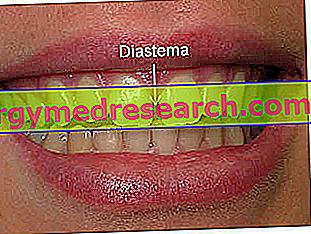What is the diastema?
"Diastema" is a purely medical term that indicates the presence of a large and showy space between two contiguous teeth. Typical of the upper incisor teeth, the diastema appears as a large black hole between the teeth, which depending on tastes and gravity gives sweetness and sympathy to the smile, or worsens the aesthetics.

So let's see what caused the diastema, what pathological repercussions it can induce and how it can be treated.
Causes
Before proceeding with any intervention to close the diastema, it is important to look for the cause that generated it.
It is considered possible that the diastema occurs in the presence of an unequal relationship between the size of the teeth and the jaw. In these cases we are faced with the problem opposed to dental crowding: when the length of the dental arch is excessive and the teeth are too small, the latter cannot occupy all the available space. For this reason, one or more spaces are created between adjacent teeth, which take the name of diastemas.

In young children, it seems that the bad habit of sucking thumbs can somehow contribute to the formation of diastemas in milk teeth.
Curiosity The presence of the diastema in the deciduous (or milk) teeth can be considered a physiological event: in fact, the "void" between two deciduous teeth must be interpreted as a space reserve for the eruption of permanent teeth (after the fall of the teeth from milk). |
The list of possible risk factors for diastema formation has not been completed. In fact, both the presence of follicular or radicular dental cysts, and the failure / poor development of the lateral incisors seem somehow to prevent or hinder the teeth from remaining adhered to one another.
Related disorders
Although the diastema generally reflects a purely aesthetic disorder, its presence in a permanent dentition can constitute, in some circumstances, a potential periodontal damage in the incisive area. The absence of a contact surface between two neighboring teeth predisposes to the risk of trauma on the interdental papilla (caused by the mechanical action of food) and the onset of an evolutionary gingivitis.
Treatment
It is not certain that all diastemas should be closed by a corrective dental operation: in fact, outside of aesthetic discomfort, many of these do not create any pathological damage to the dentition.
It is therefore up to the dentist to decide how to proceed before a diastema.
It is true, however, that the presence of a hole between the teeth is not part of the common canons of beauty: this is precisely the reason that drives many people to request a dental operation even in the absence of pathological complications.
The options are:
- Keep the diastema as it is: adequate choice when the groove between the two incisors does not reflect a morbid condition and does not create discomfort for the patient.
- Orthodontic treatment to align teeth: this first-line operation to close the diastema consists in the application of a fixture, fixed or mobile, on the teeth. The results, unfortunately, are not immediate: the diastema can close again after 6 months-2 years. The orthodontics intervention is more suitable for young patients.
- "Filler" treatment with ceramic / porcelain veneers: this intervention amplifies the size of the teeth, making them visibly larger. The ceramic veneers are thin sheets that are literally glued on the outer surface of the teeth: they are indicated in the treatment of broken, chipped, dichromic teeth (eg yellow teeth or non-removable spots by scaling) and for the correction of diastemas. Precisely, in the latter case, the aesthetic facets are made to adhere to the surface of two teeth divided by a diastema: as the surface increases, these teeth are perfectly aligned, so as to fill the groove. This option is suitable for diastemas that exceed a millimeter in width.
- Tooth coverage / replacement with artificial crowns (capsules): when the teeth that surround a diastema are carious, affected by pulpitis and do not belong to a very young, the most appropriate remedy is the treatment of the infection (filling or devitalization) followed by a tooth encapsulation with artificial ceramic or zirconium crowns.
- Dental implants: rather drastic intervention strategies for the closure of a diastema. Dental implants can only be performed in adults, especially in the presence of decayed or deeply infected teeth.
- Frenulectomy: reserved for cases of diastema dependent on structural abnormalities of the gingival frenulum. The procedure consists in cutting the frenulum, followed by its relocation in the correct position. When frenulectomy is performed on a child, the diastema tends to spontaneously close; otherwise, in the adult, the intervention must be supported by the application of a device.



